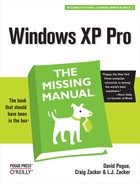Here are some typical regedit tweaks, spelled out for you step by step.
Tip
If you, too, find your pulse racing with the illicit thrill of making tweaks to your system, why stop here? You can find hundreds more RegEdit “recipes” in books, computer magazines, and Web sites (check out, for example, http://www.winguides.com and http://www.jsiinc.com/reghack.htm).
As you may have noticed, submenus in Windows (like the Control Panel, Connect to, and All Programs submenus in the Start menu) aren’t especially sprightly in Windows XP. In fact, these submenus don’t sprout until your mouse has rested on them for what feels like an eternity.
What Microsoft had in mind was ensuring that you don’t open a submenu accidentally, just by absentmindedly resting your cursor on it. But if you’re a cool, suave, sure-of-yourself customer, there’s no reason you should spend your life waiting for a time delay intended for more clueless people. This next RegEdit trick speeds up the Start menu a lot. You’ll feel like you have a new computer.
Navigate to: HKEY_CURRENT_USER→Control Panel/Desktop.
Double-click this value on the right side: MenuShowDelay.
Make this change: Change the number to 0. This number represents the amount of time, in milliseconds, between the instant you move the cursor to a submenu and when Windows finally opens the menu. (The factory setting is 400.)
Wrap up: Click OK, quit RegEdit, log out, and log back in again.
Here’s a nuisance nag that you might like to stifle: the message that not-so-helpfully points out that your desktop contains icons you haven’t opened in awhile. Using this regedit tweak, you can change the frequency of its appearance from every 60 days to any number of days you like.
Navigate to: HKEY_CURRENT_USER→Software→Microsoft→Windows→CurrentVersion→Explorer→Desktop→CleanupWiz
Double-click this value on the right side: “Days between clean up”
Make this change: Click Decimal, and then enter the number of days you’d like between cleanup nags.
Wrap up: Click OK, quit RegEdit, and restart the computer.
As you know from Section 15.3.1, one of the perks of using Windows XP (on an NTFS hard drive) is that you can encrypt files and folders, protecting them from people who try to open them from across the network or using a different account.
If you use this feature quite a bit, however, you’ll quickly grow tired of opening the Properties box every time you want to encrypt something. Wouldn’t it be much more convenient if the Encrypt and Decrypt commands were right there in the shortcut menu that appears when you right-click an icon?
Of course it would. To make it so, do this:
Navigate to: HKEY_LOCAL_MACHINE→SOFTWARE→Microsoft→Windows→CurrentVersion→ Explorer→Advanced.
Now, for this trick, you’re going to need a key that doesn’t actually exist yet. Fortunately, it’s very easy to create a new key. In this case, just right-click the Advanced “folder” and, from the shortcut menu, choose New→DWORD Value. You’ll see “New Value #1” appear in the right side of the window, ready to be renamed; type EncryptionContextMenu and then press Enter.
Double-click this value on the right side: EncryptionContextMenu.
Make this change: In the “Value data” box, type 1.
Wrap up: Click OK and quit RegEdit. When you right-click any file or folder icon, you’ll see the new Encrypt command in the shortcut menu. (Or, if it’s already encrypted, you’ll see a Decrypt command.)
Windows XP nags you every now and then to get unused icons off your desktop. But why stop there? If you’ve got the world’s most beautiful desktop wallpaper set up, you might not want any icons marring its majesty.
If you think about it, you can get by just fine without a single icon on the desktop. My Computer and similar icons are waiting in your Start menu. You can put things into the Recycle Bin without dragging them to its icon (just highlight icons and then press the Delete key, for example).
The following RegEdit hack doesn’t actually remove anything from your desktop. It just hides them. You can still work with the icons on your desktop using Windows Explorer to view the contents of your Desktop folder, for example.
Navigate to: HKEY_CURRENT_USER→Software→Microsoft→Windows→CurrentVersion→ Policies→Explorer.
Double-click this value on the right side: NoDesktop. (If you don’t see this value, create it. Right-click the Explorer folder, choose New→Binary Value, and name the new value NoDesktop.)
Make this change: In the “Value data” box, type 01 00 00 00 and click OK.
Wrap up: Click OK, quit RegEdit, and restart the PC. (To reverse the procedure, just delete the NoDesktop value you created.)
When you shut down your PC, Windows sends out an invisible “Last call! We’re closing shop, people!” message to every program and service that’s currently running. (A service is a background task that Windows is always performing, like looking for the presence of wireless networks, checking for Windows XP updates, and so on.) It gives each service or program 20 seconds to reply, “Yo, all clear here. Go ahead.”
If, after 20 seconds, Windows receives no reply from a service, it assumes that the program or service has crashed. Windows shuts it down with brute force and proceeds with the PC turnoff.
That’s an awful lot of time for you to sit there, twiddling your thumbs. Here’s how you can shorten that window of waiting opportunity, which will often make your shutdowns faster.
Navigate to: HKEY_CURRENT_USER→Control Panel→Desktop.
Double-click this value on the right side: WaitToKillAppTime.
Make this change: The value comes factory set as 20000. That’s 20 seconds, expressed as milliseconds. Change it to, for example, 50000 (five seconds).
Wrap up: Click OK. Now double-click the value called HungAppTimeout, and change it to a smaller number, too. Click OK, quit RegEdit, and restart the computer.
